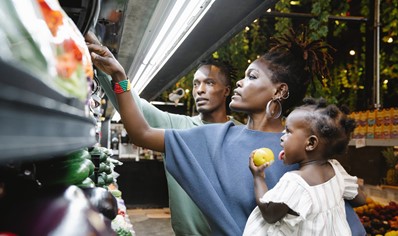
Small changes can add up to big health benefits. Eating more “superfoods” is one of the easiest ways to get more nutrition into every meal—and snack.
What is a superfood? The term is not scientific or regulated by the Food and Drug Administration or the Department of Agriculture. However, many people use the word to describe foods that, ounce per ounce, have more nutrients than others. These nutrients can include antioxidants, fiber, fatty acids, vitamins, minerals and more.
Ready to serve more superfoods to your family?
Try to add one new item per week. Watch for deals on foods like fruits and vegetables when they are in season. Stock up on canned goods and pantry items when you find a good sale.
Here are seven superfoods to consider.
Avocado
It’s the star of guacamole, a great side dish with eggs and delicious in salads. Along with all that, avocado is high in fiber, vitamins, minerals and healthy fats.
Berries
Every meal is better with blueberries, raspberries, strawberries or blackberries. Use them to top your breakfast pancakes, thicken your lunchtime smoothies and sweeten a cool glass of water at dinnertime. Berries are high in vitamins, minerals, fiber and antioxidants. They’re an easy snack and taste great at room temperature, chilled or frozen.
Dark Leafy Greens
Do you like to eat your greens? If yes, you are giving your body some of the healthiest foods possible. Kale, spinach, swiss chard, collard, dandelion and turnip greens are full of folate, zinc, calcium, iron, magnesium, vitamin C and fiber.
Dark leafy green can be enjoyed raw, with dressing or cooked into soups, pasta and stir-fries.
Garlic
Related to onions, garlic is an excellent source of fiber, manganese, vitamin C, vitamin B6 and selenium. Use garlic to liven up dips, soups and sauces. You can even roast it in the oven.
The flavor and smell are strong, so you might not want to cook with it more than once or twice a week.
Legumes
Legumes include soy and other beans, lentils, peanuts and peas. Eat legumes a few times a week and you’ll get a generous helping of B vitamins, minerals and protein. Because legumes are high in fiber, they can help you to feel fuller for longer after a snack or meal.
Nuts and Seeds
If you’re looking for a tasty way to add more fiber to your daily menu, stock up on nuts and seeds. These items are a convenient source of fiber, protein and beneficial fats.
Aim to eat 2-5 different kinds of nuts and seeds over a week. Options include pecans, walnuts, cashews, pumpkin seeds, sunflower seeds and flaxseed or meal. Look for nuts and seeds that are not salted or coated with artificial flavoring.
Salmon
Last but not least, delicious salmon offers omega-3 fatty acids, B vitamins, potassium, selenium and protein. You can grill this superfood or eat it right from a can.
Whatever superfoods you choose, remember to add different options to your diet whenever you can. A little goes a long way, so aim for eating a wide variety of superfoods—a handful of nuts one day, a few berries in your cereal the next, and a few leaves of kale the next.
It all adds up!
Complete your annual health risk assessment—earn $20 in Parkland rewards!
As a Parkland Community Health Plan member, you can earn reward points for completing certain wellness activities. Then, you can spend those points on items in the Rewards Catalog.
Want to earn $20 in reward points?
Simply complete a yearly Health Risk Assessment on the Member Portal. You will receive your reward points in approximately three months.
Call to learn about the Health Risk Assessment reward:
- Parkland HEALTHfirst (STAR Medicaid): 1-888-672-2277
- Parkland KIDSfirst (CHIP/CHIP Perinate): 1-888-814-2352
- TTY: 1-800-735-2989


